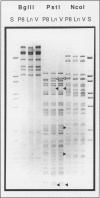Abstract
Generalized bovine herpesvirus 1 (BHV-1) infection was diagnosed in six Salers calves from the same herd. The calves had received an intramuscular injection of modified-live infectious bovine rhinotracheitis parainfluenza-3 vaccine between birth and three days of age. The purpose of this study was to determine if the outbreak was associated with the vaccine strain of BHV-1. Analysis of epidemiological data and BHV-1 DNA for restriction fragment length polymorphism was undertaken. Multifocal necrosis in multiple organs was observed on pathological examination, and the presence of BHV-1 in tissues was confirmed by immunohistochemistry. Forty-three calves (aged birth to thirty days) were vaccinated over an 11-day interval. The 10 deaths recorded for vaccinated calves were clustered over a subsequent 14-day interval. Mortality in calves vaccinated between birth and three days of age was significantly higher than in nonvaccinated calves (chi-square test; p < or = 0.025), and this mortality was characterized by a greater age at death and duration of illness for vaccinated calves (t test; p < or = 0.001). The patterns of the restriction fragments, generated by six restriction endonucleases, of BHV-1 isolated from a necropsied calf and from the vaccine were identical, and different from that of a laboratory strain of BHV-1 (P8-2). These findings support the conclusion that newborn calves were susceptible to an intramuscularly injected vaccine strain of BHV-1, and that administration of an intramuscular modified-live infectious bovine rhinotracheitis parainfluenza-3 vaccine to neonatal calves may not be an innocuous procedure.
Full text
PDF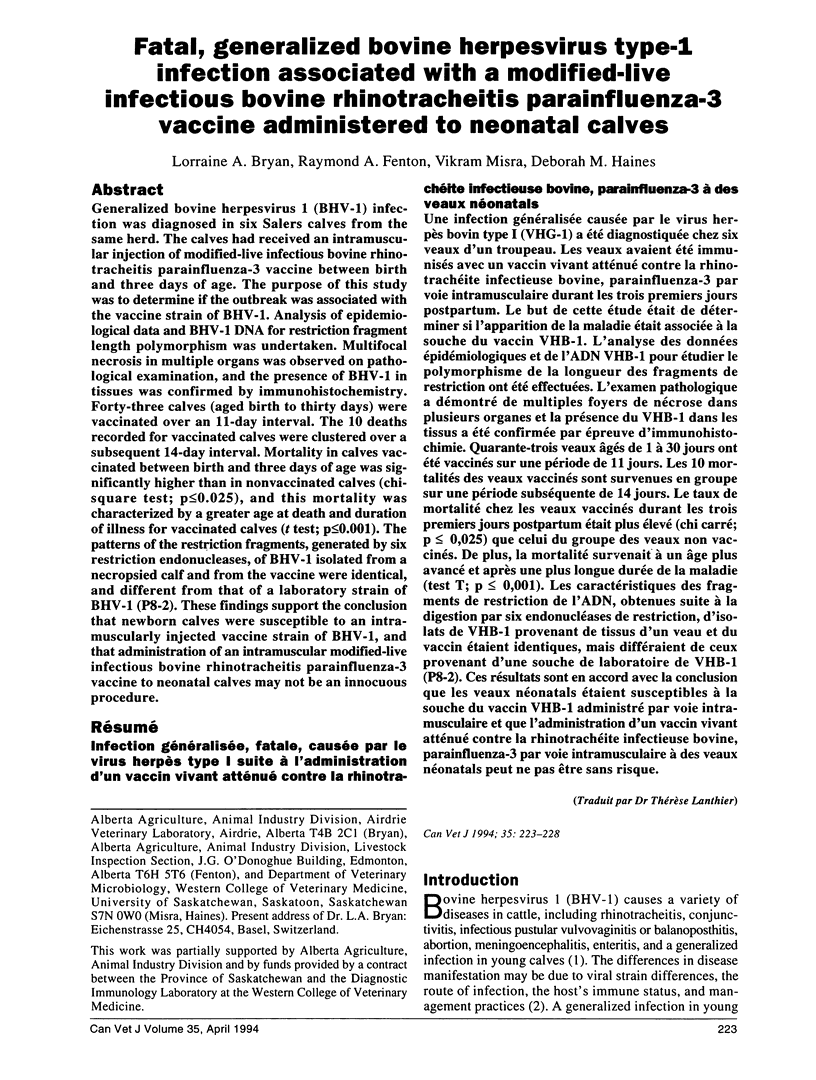
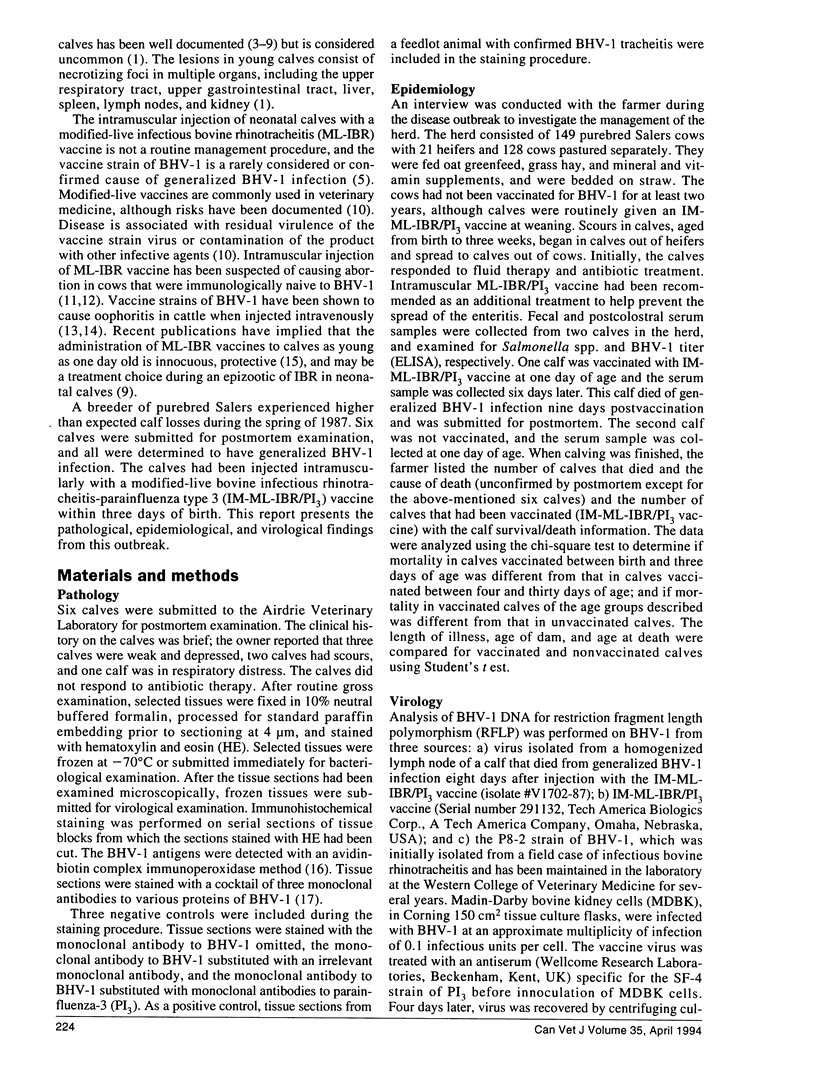
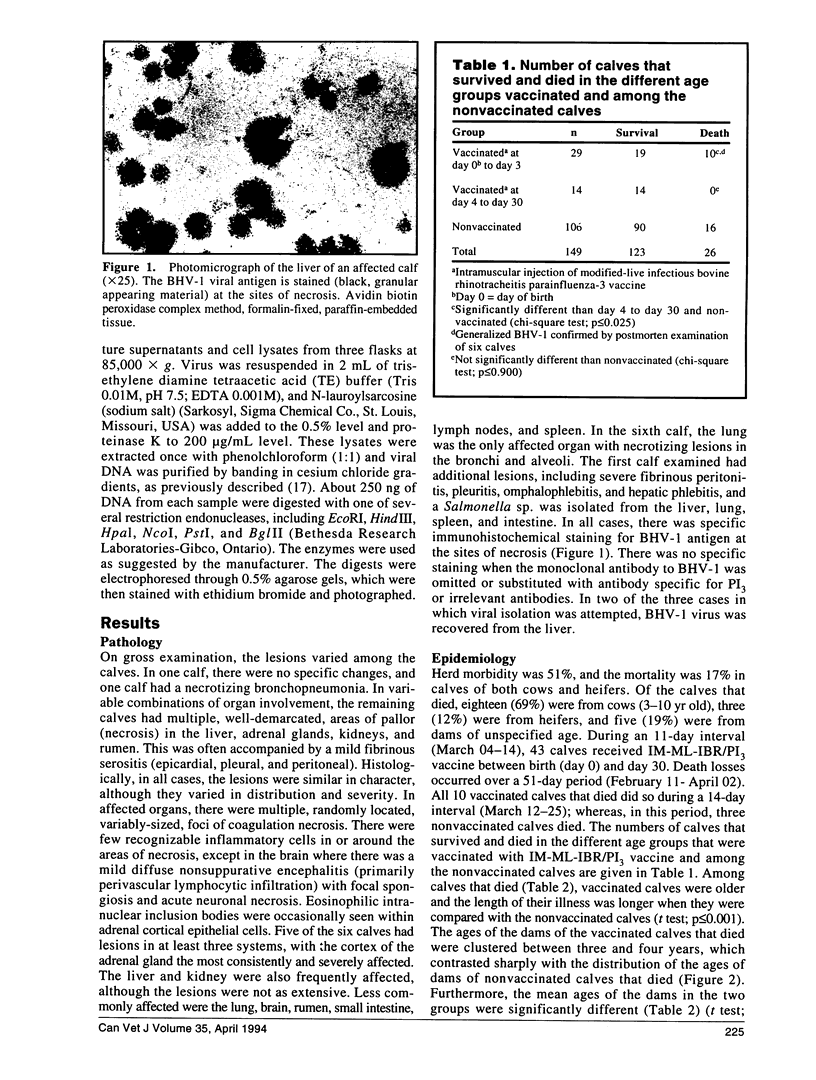
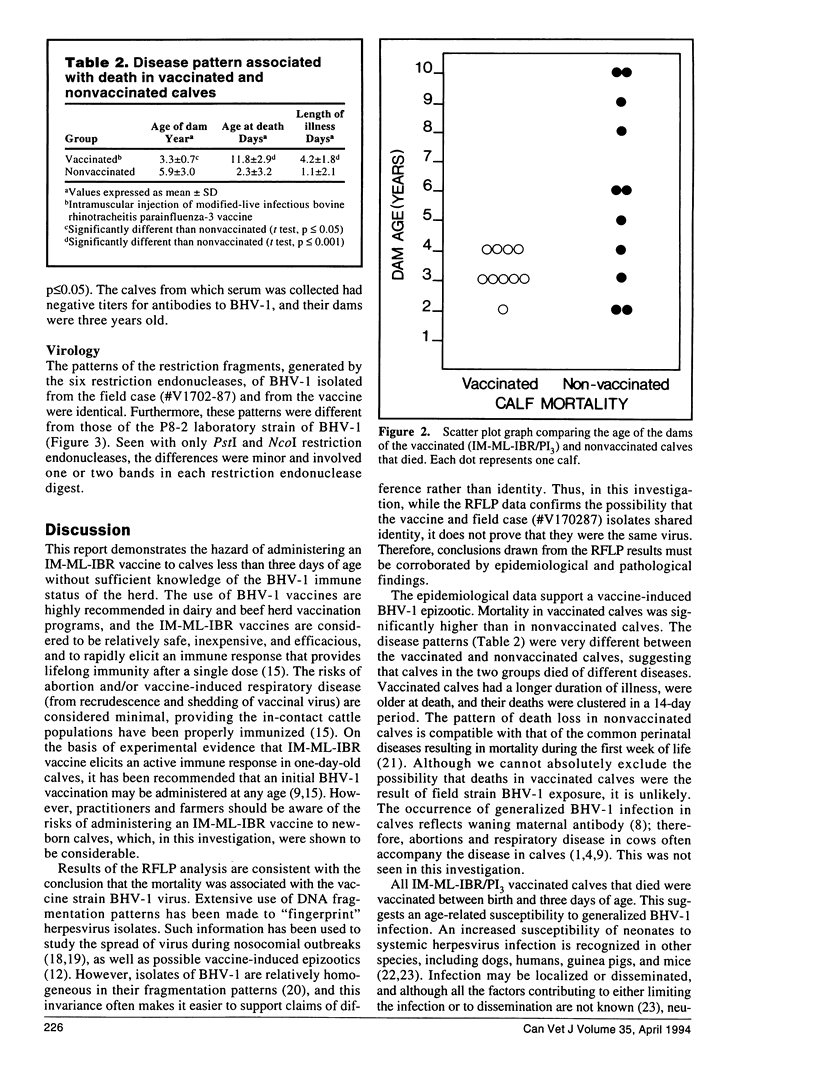
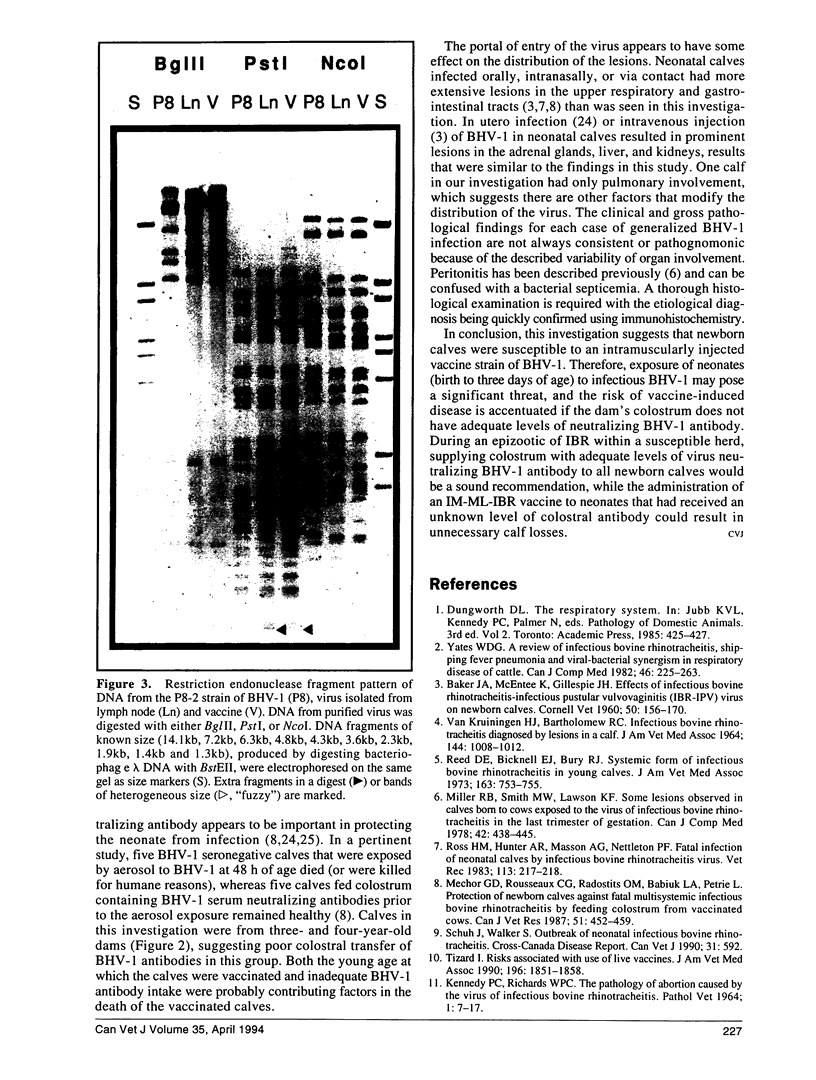
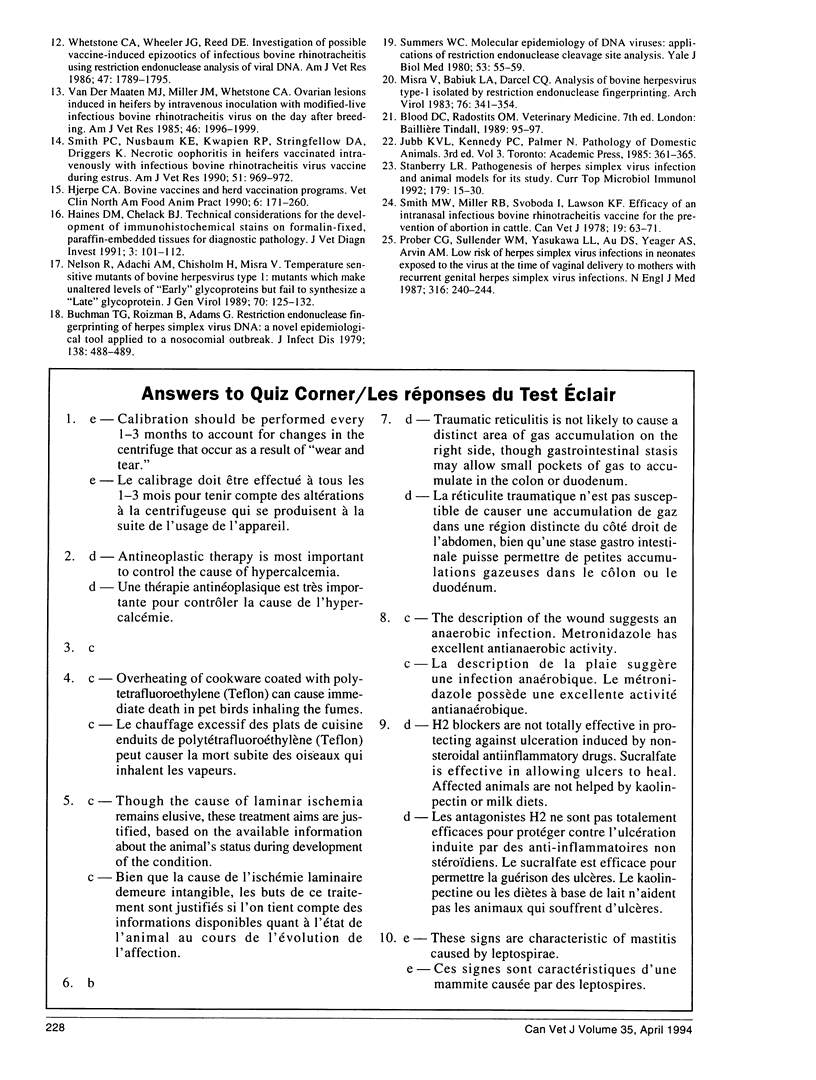
Images in this article
Selected References
These references are in PubMed. This may not be the complete list of references from this article.
- BAKER J. A., McENTEE K., GILLESPIE J. H. Effects of infectious bovine rhinotracheitis-infectious pustular vulvovaginitis (IBR-IPV) virus on newborn calves. Cornell Vet. 1960 Apr;50:156–170. [PubMed] [Google Scholar]
- Buchman T. G., Roizman B., Adams G., Stover B. H. Restriction endonuclease fingerprinting of herpes simplex virus DNA: a novel epidemiological tool applied to a nosocomial outbreak. J Infect Dis. 1978 Oct;138(4):488–498. doi: 10.1093/infdis/138.4.488. [DOI] [PubMed] [Google Scholar]
- Haines D. M., Chelack B. J. Technical considerations for developing enzyme immunohistochemical staining procedures on formalin-fixed paraffin-embedded tissues for diagnostic pathology. J Vet Diagn Invest. 1991 Jan;3(1):101–112. doi: 10.1177/104063879100300128. [DOI] [PubMed] [Google Scholar]
- Hannah H. W. Clarification of a legal brief case. J Am Vet Med Assoc. 1990 Jan 15;196(2):185–185. [PubMed] [Google Scholar]
- Hjerpe C. A. Bovine vaccines and herd vaccination programs. Vet Clin North Am Food Anim Pract. 1990 Mar;6(1):167–260. [PubMed] [Google Scholar]
- Mechor G. D., Rousseaux C. G., Radostits O. M., Babiuk L. A., Petrie L. Protection of newborn calves against fatal multisystemic infectious bovine rhinotracheitis by feeding colostrum from vaccinated cows. Can J Vet Res. 1987 Oct;51(4):452–459. [PMC free article] [PubMed] [Google Scholar]
- Miller R. B., Smith M. W., Lawson K. F. Some lesions observed in calves born to cows exposed to the virus of infectious bovine rhinotracheitis in the last trimester of gestation. Can J Comp Med. 1978 Oct;42(4):438–445. [PMC free article] [PubMed] [Google Scholar]
- Misra V., Babiuk L. A., Darcel C. L. Analysis of bovine herpes virus-type 1 isolates by restriction endonuclease fingerprinting. Arch Virol. 1983;76(4):341–354. doi: 10.1007/BF01311201. [DOI] [PubMed] [Google Scholar]
- Nelson R., Adachi A. M., Chisholm H., Misra V. Temperature-sensitive mutants of bovine herpesvirus type 1: mutants which make unaltered levels of 'early' glycoproteins but fail to synthesize a 'late' glycoprotein. J Gen Virol. 1989 Jan;70(Pt 1):125–132. doi: 10.1099/0022-1317-70-1-125. [DOI] [PubMed] [Google Scholar]
- Prober C. G., Sullender W. M., Yasukawa L. L., Au D. S., Yeager A. S., Arvin A. M. Low risk of herpes simplex virus infections in neonates exposed to the virus at the time of vaginal delivery to mothers with recurrent genital herpes simplex virus infections. N Engl J Med. 1987 Jan 29;316(5):240–244. doi: 10.1056/NEJM198701293160503. [DOI] [PubMed] [Google Scholar]
- Reed D. E., Bicknell E. J., Bury R. J. Systemic form of infectious bovine rhinotracheitis in young calves. J Am Vet Med Assoc. 1973 Oct 1;163(7):753–755. [PubMed] [Google Scholar]
- Ross H. M., Hunter A. R., Masson A. G., Nettleton P. F. Fatal infection of neonatal calves by infectious bovine rhinotracheitis virus. Vet Rec. 1983 Sep 3;113(10):217–218. doi: 10.1136/vr.113.10.217. [DOI] [PubMed] [Google Scholar]
- Schuh J., Walker S. Saskatchewan. Outbreak of neonatal infectious bovine rhinotracheitis. Can Vet J. 1990 Aug;31(8):592–592. [PMC free article] [PubMed] [Google Scholar]
- Smith M. W., Miller R. B., Svoboda I., Lawson K. F. Efficacy of an intranasal infectious bovine rhinotracheitis vaccine for the prevention of abortion in cattle. Can Vet J. 1978 Mar;19(3):63–71. [PMC free article] [PubMed] [Google Scholar]
- Smith P. C., Nusbaum K. E., Kwapien R. P., Stringfellow D. A., Driggers K. Necrotic oophoritis in heifers vaccinated intravenously with infectious bovine rhinotracheitis virus vaccine during estrus. Am J Vet Res. 1990 Jul;51(7):969–972. [PubMed] [Google Scholar]
- Stanberry L. R. Pathogenesis of herpes simplex virus infection and animal models for its study. Curr Top Microbiol Immunol. 1992;179:15–30. doi: 10.1007/978-3-642-77247-4_2. [DOI] [PubMed] [Google Scholar]
- Summers W. C. Molecular epidemiology of DNA viruses: applications of restriction endonuclease cleavage site analysis. Yale J Biol Med. 1980 Jan-Feb;53(1):55–59. [PMC free article] [PubMed] [Google Scholar]
- VANKRUININGEN H. J., BARTHOLOMEW R. C. INFECTIOUS BOVINE RHINOTRACHEITIS DIAGNOSED BY LESIONS IN A CALF. J Am Vet Med Assoc. 1964 May 1;144:1008–1012. [PubMed] [Google Scholar]
- Van der Maaten M. J., Miller J. M., Whetstone C. A. Ovarian lesions induced in heifers by intravenous inoculation with modified-live infectious bovine rhinotracheitis virus on the day after breeding. Am J Vet Res. 1985 Sep;46(9):1996–1999. [PubMed] [Google Scholar]
- Whetstone C. A., Wheeler J. G., Reed D. E. Investigation of possible vaccine-induced epizootics of infectious bovine rhinotracheitis, using restriction endonuclease analysis of viral DNA. Am J Vet Res. 1986 Aug;47(8):1789–1795. [PubMed] [Google Scholar]
- Yates W. D. A review of infectious bovine rhinotracheitis, shipping fever pneumonia and viral-bacterial synergism in respiratory disease of cattle. Can J Comp Med. 1982 Jul;46(3):225–263. [PMC free article] [PubMed] [Google Scholar]




